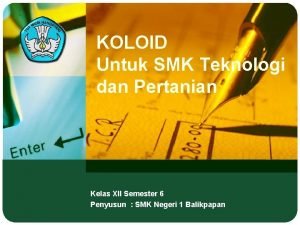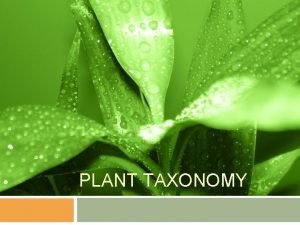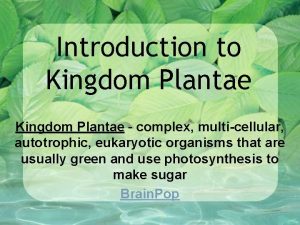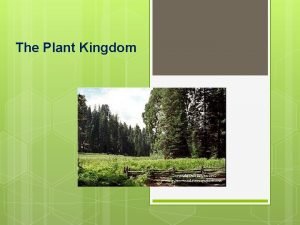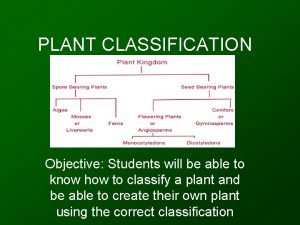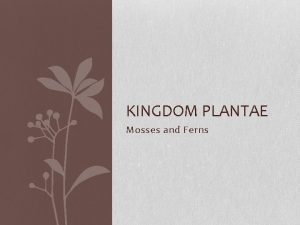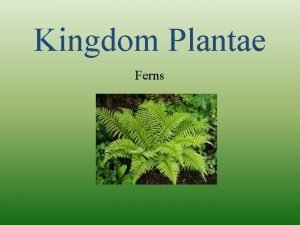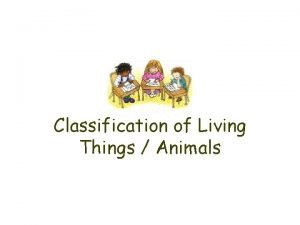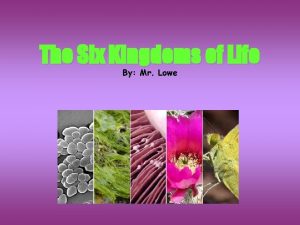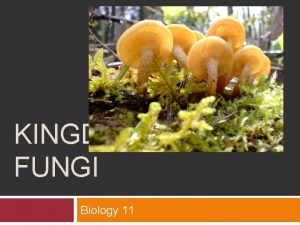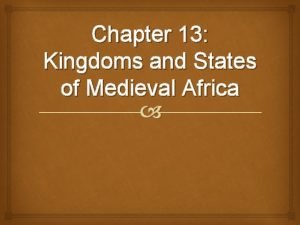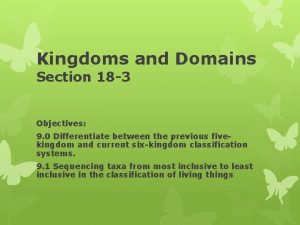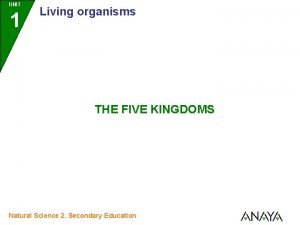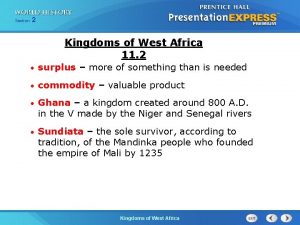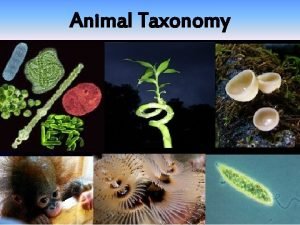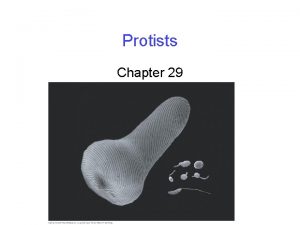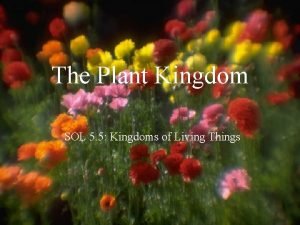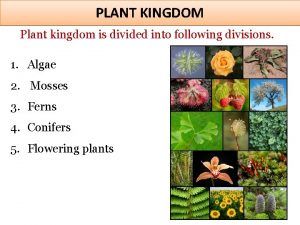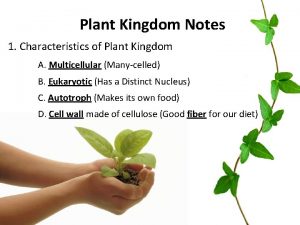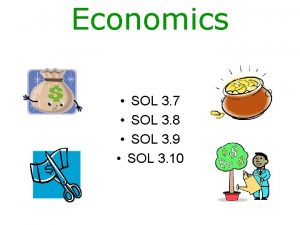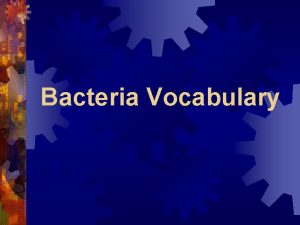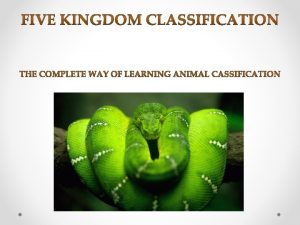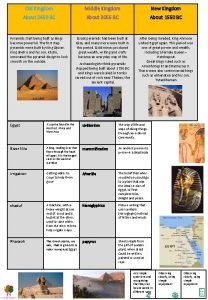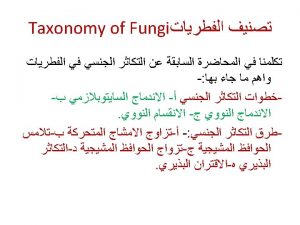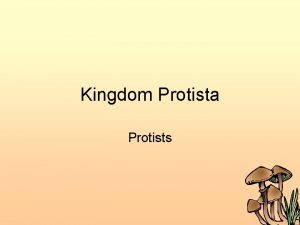The Plant Kingdom SOL 5 5 Kingdoms of
















































































- Slides: 80

The Plant Kingdom SOL 5. 5: Kingdoms of Living Things

Plant Classification • • • Domain: Eukaryota Kingdom: Plantae Cell type: eukaryotic Cell number: multicellular Feeding: autotrophic (photosynthesis) • Reproduction: sexual (seeds)

Plant Classification • Plants evolved from green algae (protists) • They are first classified as – Nonvascular – short plants with no transport tissue (like veins), e. g. moss – Vascular – taller plants with veins, e. g. trees • Xylem – veins for water • Phloem – veins for food

Non-Vascular • Moss

Non-Vascular • Liverwort

Non-Vascular • Fern

Non-Vascular • Hornwort

Vascular • American dogwood tree

Vascular • Roses

Vascular • Grass

Plant Classification • Vascular Plants can further be classified as – Gymnosperms – cone bearing plants, e. g. pine trees – Angiosperms – flowering plants, e. g. roses

Plant Classification • Angiosperms are classified as – Monocots: flowering plants with parallel veins and petals in multiples of 3, e. g. Tulip – Dicots: flowering plants with branching veins and petals in multiples of 4 or 5, e. g. Rose • Regardless of type, flowers are great for sexual reproduction. Flowers attract animals that can help pollinate the plant.

Photosynthesis • Plant cells produce their own food through a process called photosynthesis. • Photosynthesis allows plants to convert light energy into food energy.

Parts of a Flower Male Parts Female Parts Each flower has both male and female parts. Male parts produce pollen while female parts produce ovules. Pollen + Ovule = Seed. Fruits sometimes grow from the swollen ovary as a means to transport seeds.

Parts of a Flower Male Parts Female Parts Flowers form mutualistic symbiotic relationships with pollinators like insects and birds. Plants attract them with petals and create a nectar the pollinators eat. In return the pollinators carry pollen to other plants.

Plant Cell chloroplasts cell wall nucleus cell membrane cytoplasm vacuoles

SOL Released Test Items































































 Roman empire
Roman empire Mentohotep
Mentohotep Old kingdom middle kingdom new kingdom
Old kingdom middle kingdom new kingdom Old kingdom middle kingdom new kingdom
Old kingdom middle kingdom new kingdom Koloid liofil
Koloid liofil Plantae kingdom drawing
Plantae kingdom drawing Protista
Protista The odds and ends kingdom
The odds and ends kingdom Cool protists
Cool protists Fruits one
Fruits one Maize classification
Maize classification Which kingdom is autotrophic
Which kingdom is autotrophic Plant kingdom characteristics
Plant kingdom characteristics Plant kingdom classification
Plant kingdom classification Archaebacteria protista fungi plantae animalia
Archaebacteria protista fungi plantae animalia Character of plant
Character of plant Ferns
Ferns Kingdom of ferns
Kingdom of ferns Tronsmo plant pathology and plant diseases download
Tronsmo plant pathology and plant diseases download Scope of plant breeding
Scope of plant breeding Tronsmo plant pathology and plant diseases download
Tronsmo plant pathology and plant diseases download Plant introduction in plant breeding
Plant introduction in plant breeding Albugo eye
Albugo eye Plant introduction in plant breeding
Plant introduction in plant breeding Dot
Dot Vẽ hình chiếu đứng bằng cạnh của vật thể
Vẽ hình chiếu đứng bằng cạnh của vật thể độ dài liên kết
độ dài liên kết Môn thể thao bắt đầu bằng từ đua
Môn thể thao bắt đầu bằng từ đua Chó sói
Chó sói Thiếu nhi thế giới liên hoan
Thiếu nhi thế giới liên hoan Khi nào hổ mẹ dạy hổ con săn mồi
Khi nào hổ mẹ dạy hổ con săn mồi điện thế nghỉ
điện thế nghỉ Thế nào là sự mỏi cơ
Thế nào là sự mỏi cơ Một số thể thơ truyền thống
Một số thể thơ truyền thống Trời xanh đây là của chúng ta thể thơ
Trời xanh đây là của chúng ta thể thơ Ng-html
Ng-html Bảng số nguyên tố
Bảng số nguyên tố Fecboak
Fecboak Các châu lục và đại dương trên thế giới
Các châu lục và đại dương trên thế giới Thế nào là hệ số cao nhất
Thế nào là hệ số cao nhất Tư thế worms-breton
Tư thế worms-breton Hệ hô hấp
Hệ hô hấp Tư thế ngồi viết
Tư thế ngồi viết đặc điểm cơ thể của người tối cổ
đặc điểm cơ thể của người tối cổ Cái miệng nó xinh thế chỉ nói điều hay thôi
Cái miệng nó xinh thế chỉ nói điều hay thôi Mật thư anh em như thể tay chân
Mật thư anh em như thể tay chân Bổ thể
Bổ thể ưu thế lai là gì
ưu thế lai là gì Tư thế ngồi viết
Tư thế ngồi viết Thẻ vin
Thẻ vin Thể thơ truyền thống
Thể thơ truyền thống Các châu lục và đại dương trên thế giới
Các châu lục và đại dương trên thế giới Từ ngữ thể hiện lòng nhân hậu
Từ ngữ thể hiện lòng nhân hậu Diễn thế sinh thái là
Diễn thế sinh thái là Vẽ hình chiếu vuông góc của vật thể sau
Vẽ hình chiếu vuông góc của vật thể sau Thứ tự các dấu thăng giáng ở hóa biểu
Thứ tự các dấu thăng giáng ở hóa biểu Làm thế nào để 102-1=99
Làm thế nào để 102-1=99 Chúa yêu trần thế alleluia
Chúa yêu trần thế alleluia Tỉ lệ cơ thể trẻ em
Tỉ lệ cơ thể trẻ em Lời thề hippocrates
Lời thề hippocrates Hổ sinh sản vào mùa nào
Hổ sinh sản vào mùa nào đại từ thay thế
đại từ thay thế Quá trình desamine hóa có thể tạo ra
Quá trình desamine hóa có thể tạo ra Công của trọng lực
Công của trọng lực Hình ảnh bộ gõ cơ thể búng tay
Hình ảnh bộ gõ cơ thể búng tay Thế nào là mạng điện lắp đặt kiểu nổi
Thế nào là mạng điện lắp đặt kiểu nổi 3 domain 6 kingdom
3 domain 6 kingdom What are the six kingdoms of life?
What are the six kingdoms of life? Biological taxonomy
Biological taxonomy Biology
Biology Cladogram of kingdom animalia
Cladogram of kingdom animalia Medieval kingdoms in europe lesson 1
Medieval kingdoms in europe lesson 1 Chapter 13 kingdoms and states of medieval africa
Chapter 13 kingdoms and states of medieval africa 6 kingdoms chart
6 kingdoms chart Section 18-3 kingdoms and domains
Section 18-3 kingdoms and domains Examples of animal organs
Examples of animal organs How did the kingdoms of west africa develop and prosper
How did the kingdoms of west africa develop and prosper Chapter 17 section 1 the history of classification
Chapter 17 section 1 the history of classification Three kingdoms science
Three kingdoms science Pepidoglycan
Pepidoglycan Why are protists paraphyletic
Why are protists paraphyletic




